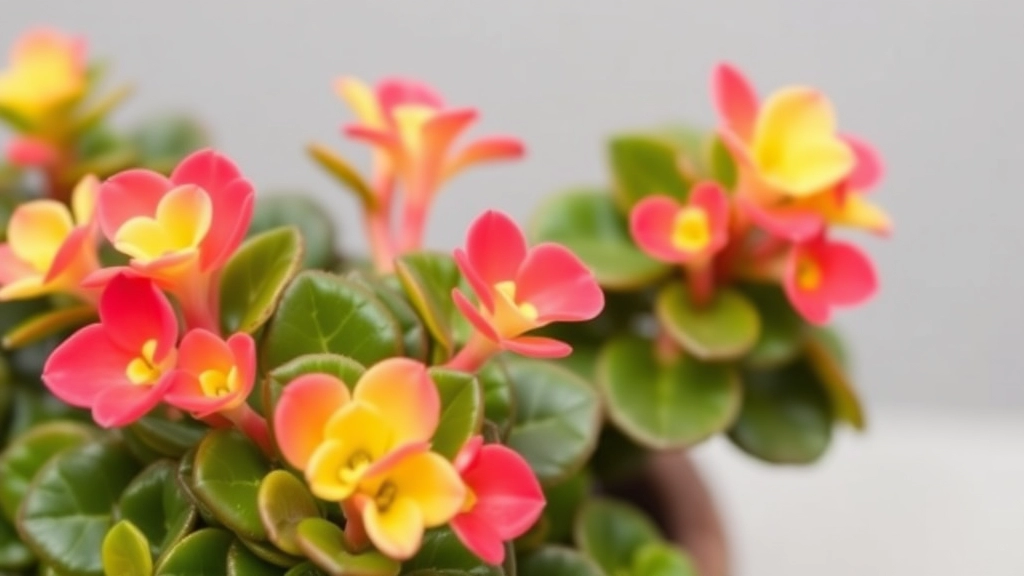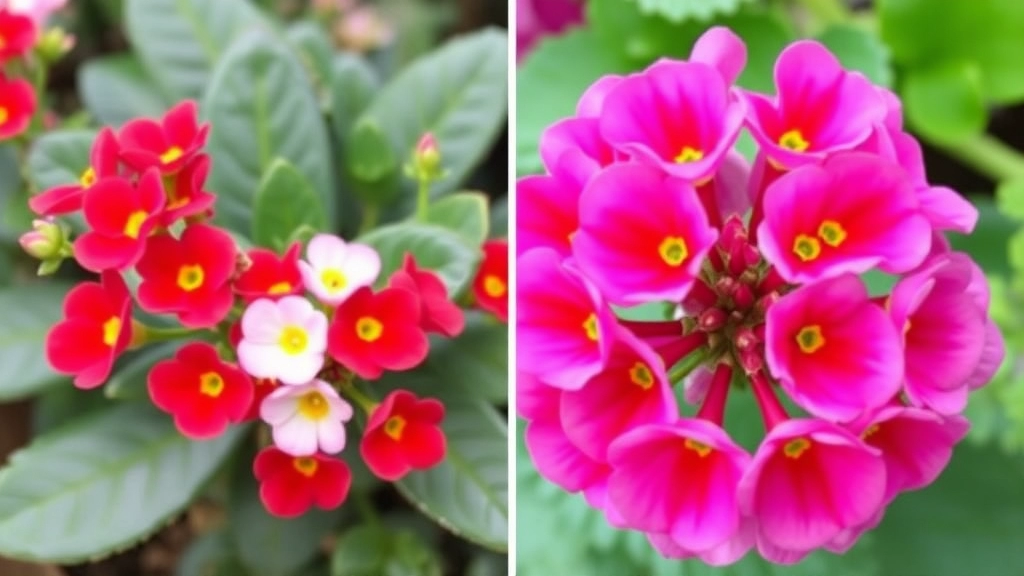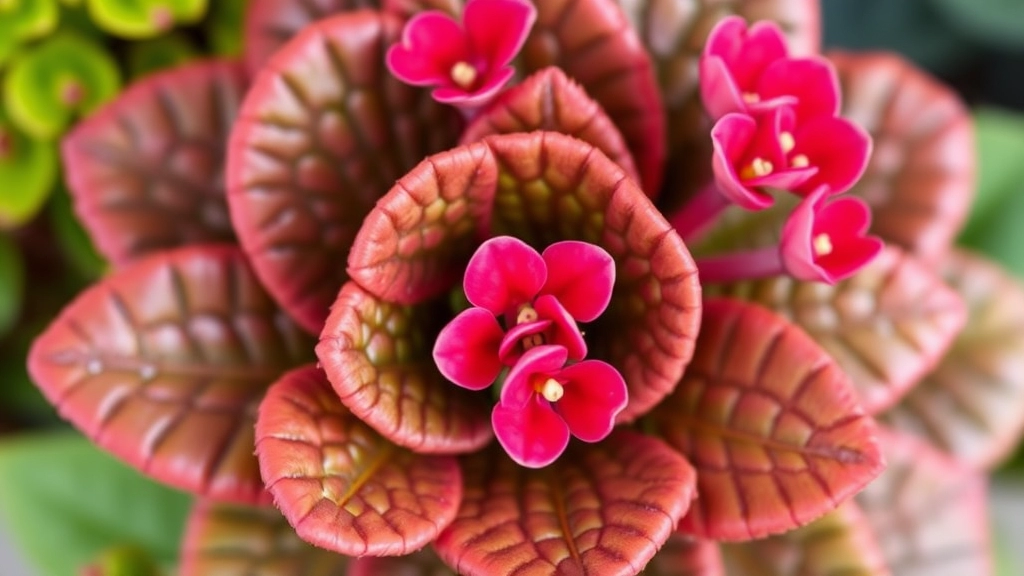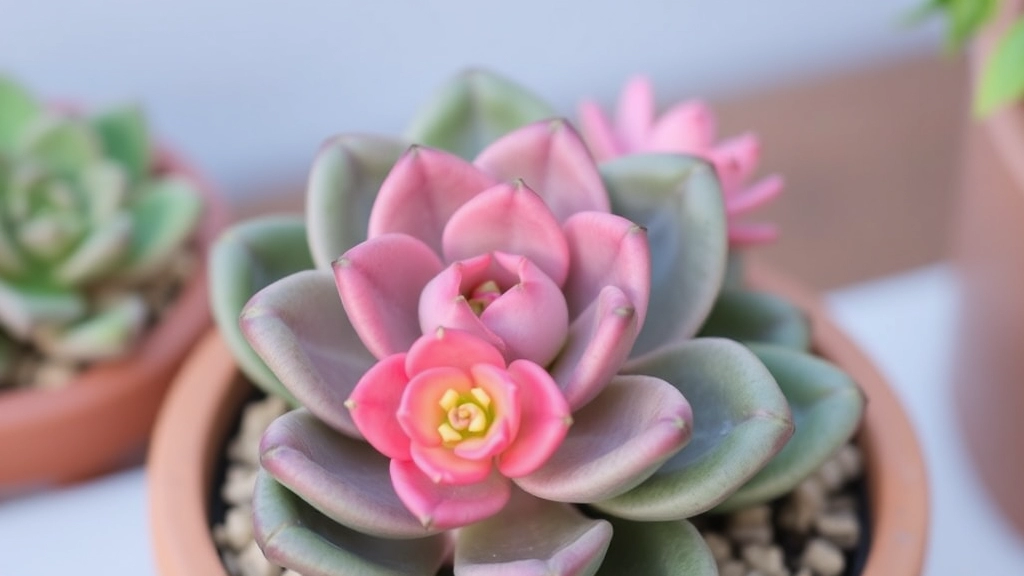Kalanchoe: A Touch of Green for Your Home
If you’re looking to add a touch of green to your home or garden, the succulent plant Kalanchoe is a fantastic choice. Known for its vibrant flowers and easy-care nature, this plant can thrive with minimal effort. Whether you’re a seasoned gardener or a beginner, understanding the best growing conditions for Kalanchoe can make all the difference.
Watering Your Kalanchoe
Watering your Kalanchoe correctly is crucial for its health. This succulent prefers a “soak and dry” method, where you let the soil dry out completely between waterings. Additionally, providing the right amount of sunlight will ensure your Kalanchoe grows strong and blooms beautifully.
Essential Care Tips
Keep reading to discover more essential care tips and how to troubleshoot common issues like pests or wilting.
Best Growing Conditions for Kalanchoe
Are you wondering how to create the perfect environment for your Kalanchoe plants?
These hardy succulents thrive in specific conditions that can make a world of difference in their growth and overall health.
Ideal Temperature
- Warmth is Key: Kalanchoe prefers temperatures between 18°C to 24°C (65°F to 75°F).
- Avoid Frost: Protect your plants from temperatures below 10°C (50°F), as they are sensitive to cold.
Humidity Levels
- Low Humidity: These plants thrive in low humidity environments, making them perfect for indoor settings.
- Air Circulation: Ensure good air circulation around the plant to prevent fungal issues.
Soil Type
- Well-Draining Soil: Use a cactus or succulent mix that ensures quick drainage. For more details, check out the best soil for Kalanchoe Blossfeldiana care tips.
- pH Level: Aim for a slightly acidic to neutral pH (6.0 to 7.0) for optimal growth.
Container Choice
- Pot Selection: Choose pots with drainage holes to prevent waterlogging. Learn more about how to care for Kalanchoe succulents.
- Size Matters: A pot that’s too large can retain excess moisture, leading to root rot.
Essential Watering Tips for Kalanchoe

So, you’ve got your Kalanchoe and you’re excited to see it thrive. But one of the biggest questions is: how much should you actually water it?
Let’s dive into some essential watering tips that’ll keep your plant happy and healthy.
1. Watering Frequency
- Less is More: Kalanchoes are succulents, which means they store water in their leaves. This makes them more tolerant of drought.
- Check the Soil: Before watering, stick your finger about an inch into the soil. If it feels dry, it’s time to give it a drink. If it’s still moist, hold off a bit longer.
2. Watering Technique
- Water Deeply: When you do water, make sure to soak the soil thoroughly. This encourages deep root growth.
- Drainage is Key: Always ensure your pot has drainage holes. Standing water can lead to root rot, which is a quick way to say goodbye to your plant.
3. Seasonal Adjustments
- Winter Care: In winter, your Kalanchoe will need less water. Cut back to about once every two to three weeks.
- Summer Boost: During the warmer months, you might find yourself watering more frequently—maybe every week or so, depending on your home’s humidity.
4. Signs of Overwatering
- Yellow Leaves: If you notice leaves turning yellow or mushy, it’s a sign you might be giving it too much love in the water department.
- Droopy Stems: A droopy Kalanchoe could indicate it’s not getting enough water, but it can also mean it’s been overwatered. Always check the soil first!
5. Water Quality
- Tap Water is Fine: Most Kalanchoes do well with regular tap water. Just let it sit out for a few hours to allow chlorine to evaporate.
- Rainwater: If you can collect rainwater, that’s a bonus! It’s often softer and free from chemicals.
Light Requirements for Optimal Kalanchoe Growth
Many plant enthusiasts often wonder why their Kalanchoe isn’t thriving as expected. One of the most crucial aspects of Kalanchoe care is ensuring that your plant receives the right amount of light.
Kalanchoe plants are native to Madagascar, where they bask in bright, indirect sunlight. To replicate these conditions, follow these essential light requirements:
- Bright Indirect Light: Place your Kalanchoe near a window where it can receive bright but indirect sunlight. Direct sunlight can scorch the leaves, while too little light can hinder growth.
- Duration: Aim for about 6 hours of light per day. Morning sunlight is ideal, as it’s less intense than afternoon rays.
- Artificial Lighting: If natural light is limited, consider using grow lights. Position them about 12-18 inches above the plant for optimal results.
- Seasonal Adjustments: Be mindful of seasonal changes. During winter months, Kalanchoe may require more light, so adjust its position accordingly.
- Signs of Insufficient Light: If your Kalanchoe’s leaves are stretching or becoming leggy, it’s a clear signal that it needs more light.
Understanding the light requirements for Kalanchoe is essential for fostering robust growth and vibrant blooms. For more detailed guidance, check out our expert tips on Kalanchoe care and explore the top Kalanchoe succulent varieties to find the perfect plant for your home.
Common Kalanchoe Varieties and Their Unique Features

As we delve into the fascinating world of Kalanchoe, it’s essential to understand the various varieties available, each with its unique charm and characteristics. Selecting the right type can greatly enhance your gardening experience and ensure your plant thrives.
Kalanchoe Blossfeldiana
- Description: Often known as the Flaming Katy, this variety is famous for its vibrant clusters of flowers.
- Features:
- Blooms in a range of colours, including red, pink, yellow, and white.
- Grows up to 30 cm tall, making it perfect for indoor settings.
- Ideal for beginners due to its low maintenance needs.
Kalanchoe Tomentosa
- Description: Commonly referred to as the Panda Plant, this variety stands out with its fuzzy, grey-green leaves.
- Features:
- Leaves are edged with brown, resembling panda ears.
- Produces small, tubular flowers that are typically yellow or orange.
- Thrives in bright light, making it a suitable choice for sunny windowsills.
Kalanchoe Thyrsiflora
- Description: Known as the Mother of Thousands, this variety is recognised for its unique leaf structure.
- Features:
- Thick, oval leaves that can grow up to 15 cm long.
- Produces small clusters of yellow flowers on tall stalks.
- Can propagate easily, as it produces small plantlets along the edges of its leaves.
Kalanchoe Luciae
- Description: Often called the Paddle Plant, this variety is notable for its striking, paddle-shaped leaves.
- Features:
- Leaves can develop a stunning red edge when exposed to bright light.
- Grows up to 60 cm tall, making it a standout in any collection.
- Requires minimal watering, making it perfect for those who may forget to tend to their plants regularly.
Kalanchoe beharensis
- Description: Known as the Elephant Ear, this variety is distinguished by its large, textured leaves.
- Features:
- Leaves can grow up to 30 cm long and have a unique, velvety texture.
- Produces tall flower spikes with tubular flowers in shades of orange and red.
- Prefers a warm climate and well-draining soil.
Understanding these common Kalanchoe varieties can help you choose the right plant for your home or garden. Each type brings its unique aesthetic and care requirements, ensuring there’s a perfect match for every plant enthusiast.
How to Propagate Kalanchoe Plants Successfully
Are you looking to expand your Kalanchoe collection without breaking the bank? Propagating Kalanchoe plants is not only budget-friendly but also incredibly rewarding. Let’s delve into the straightforward methods to propagate these vibrant succulents effectively.
Troubleshooting Common Problems with Kalanchoe

So, you’ve got your Kalanchoe, and it’s not looking quite right? You’re not alone; many of us have been there. Let’s dive into some common issues and how to tackle them head-on.
1. Leaves Turning Yellow
What’s Happening?
Yellow leaves can be a sign of overwatering or poor drainage.
Quick Fixes:
- Check the Soil: Is it soggy? Let it dry out between waterings.
- Repot if Needed: Use a pot with drainage holes.
2. Dropping Leaves
What’s Happening?
If your Kalanchoe is shedding leaves, it might be a sign of stress.
Quick Fixes:
- Adjust Watering: Ensure you’re not underwatering or overwatering.
- Temperature Check: Kalanchoes prefer a stable environment. Avoid drafts and sudden temperature changes.
3. No Flowers
What’s Happening?
Sometimes, you might find your Kalanchoe isn’t blooming.
Quick Fixes:
- Light Requirements: Ensure it’s getting enough light. They love bright, indirect light.
- Fertilisation: A balanced fertiliser during the growing season can help.
4. Pests Invading
What’s Happening?
Pests like mealybugs and aphids can be a real nuisance.
Quick Fixes:
- Inspect Regularly: Check the undersides of leaves.
- Natural Remedies: Use neem oil or insecticidal soap to get rid of them.
5. Wilting
What’s Happening?
Wilting can indicate underwatering or root rot.
Quick Fixes:
- Assess Watering Schedule: If the soil is dry, give it a drink.
- Inspect Roots: If they’re mushy, it’s time to repot and cut away the rotten parts.
6. Leggy Growth
What’s Happening?
If your Kalanchoe is stretching towards the light, it’s not getting enough.
Quick Fixes:
- Move to a Brighter Spot: Ensure it’s in a location with plenty of indirect sunlight.
- Prune Back: Trim back the leggy stems to encourage bushier growth.
To keep your Kalanchoe thriving and blooming throughout the seasons, consider the following strategies:
– **Light Management:** Ensure your plant receives bright, indirect light. Kalanchoe thrives in well-lit environments. If possible, place it near a window where it can soak up sunlight for several hours a day.
– **Temperature Control:** Kalanchoe prefers warmer temperatures, ideally between 15°C to 25°C. Avoid exposing your plant to cold drafts, as this can hinder blooming. For more detailed information on temperature preferences, check out the [ideal temperature for Kalanchoe blossfeldiana growth](https://planthq.org/ideal-temperature-for-kalanchoe-blossfeldiana-growth/).
– **Fertilisation:** Use a balanced, water-soluble fertiliser every 2-4 weeks during the growing season (spring and summer). This gives your Kalanchoe the nutrients it needs to produce flowers.
– **Pruning:** After the blooming period, prune back any dead or wilted flowers. This encourages new growth and can stimulate further blooming.
– **Watering Routine:** Allow the soil to dry out between waterings. Overwatering can lead to root rot, while underwatering can stress the plant, both of which can affect blooming. For best practices, refer to the [watering guide for Kalanchoe tomentosa](https://planthq.org/kalanchoe-tomentosa-watering-best-practices-tips/).
– **Rest Period:** After the blooming season, give your Kalanchoe a rest period. Reduce watering and stop fertilising for about a month. This helps the plant conserve energy for its next blooming cycle.
– **Day Length Control:** Kalanchoe is a short-day plant, meaning it requires longer nights to trigger blooming. Consider placing it in a dark area for at least 14 hours a day for several weeks to encourage flower production.
FAQs about Succulent Plant Kalanchoe
How often should I water my Kalanchoe?
Less is more when it comes to watering Kalanchoe. These succulents store water in their leaves, making them drought-tolerant. Check the soil before watering; if it feels dry about an inch deep, it’s time to water. Typically, you may water them weekly in summer and every two to three weeks in winter.
What is the best way to water my Kalanchoe?
Water deeply to ensure the soil is thoroughly soaked, which promotes deep root growth. Always use pots with drainage holes to prevent root rot caused by standing water.
What are the signs of overwatering my Kalanchoe?
Overwatering can cause yellow leaves and mushy stems. If you notice these signs, check the soil moisture and adjust your watering schedule accordingly.
Can I use tap water for my Kalanchoe?
Yes, tap water is generally fine for Kalanchoe. Let it sit out for a few hours to allow chlorine to evaporate. Alternatively, rainwater is an excellent option as it’s softer and free from chemicals.
What are some common varieties of Kalanchoe?
Some popular Kalanchoe varieties include:
- Kalanchoe Blossfeldiana: Known for its vibrant clusters of flowers.
- Kalanchoe Tomentosa: Recognized for its fuzzy, grey-green leaves.
- Kalanchoe Thyrsiflora: Features thick, oval leaves and small yellow flowers.
- Kalanchoe Luciae: Notable for its paddle-shaped leaves with red edges.
- Kalanchoe Beharensis: Distinguished by its large, textured leaves.
Why are my Kalanchoe leaves turning yellow?
Yellow leaves can be a sign of overwatering or poor drainage. Ensure the soil dries out between waterings and consider repotting in a container with drainage holes if necessary.
Why is my Kalanchoe dropping leaves?
Leaf drop can indicate stress, often due to improper watering or temperature fluctuations. Adjust your watering schedule and maintain a stable environment to alleviate this issue.
What should I do if my Kalanchoe isn’t blooming?
Ensure your Kalanchoe is getting enough bright, indirect light and consider using a balanced fertiliser during the growing season to encourage blooming.
How can I deal with pests on my Kalanchoe?
Inspect your plant regularly for pests like mealybugs and aphids, especially on the undersides of leaves. Use natural remedies such as neem oil or insecticidal soap to manage infestations.
Why is my Kalanchoe wilting?
Wilting can be caused by underwatering or root rot. Check the soil moisture and adjust your watering schedule. If the roots are mushy, repot the plant and remove any rotten parts.
What can I do about leggy growth in my Kalanchoe?
Leggy growth indicates insufficient light. Move your plant to a brighter spot with indirect sunlight and prune back the leggy stems to encourage bushier growth.
References
-
How to Grow Kalanchoe Succulents
-
Kalanchoe Plant Care: Learn How To Grow Kalanchoe Plants
-
Kalanchoe: How to Grow and Care for Kalanchoe Plants
